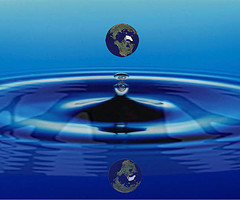[This article is part of a four part series on how to get create with tapping when you are stuck or bored with tapping. A new part willed be added every few weeks. See the parts that have been published so far and check back regularly to see the full series.]

photo by Maureen Flynn-Burhoe |
Mechanically tapping/Emotional Freedom Techniques (EFT) is a very easy thing to do. All you need is to provide stimulus to the tapping points plus tuning into the issue at hand. The tapping part is easy; what can be hard is the tuning in part. Often we are so close to an issue or we have been working on an issue that it is difficult to see it clearly.
Recently Jeremy Dean's PSYBlog had a very interesting two part series (via kottke.org) which explored 14 of ways we can become more creative and more efficient problem solvers. In this four part series I am going to explore how we can apply many of these insights to tune into our issues in new ways (plus a few of my own).
Obviously not all of these are going to work for every issue, but by having a complete menu to choose from you are going to find new ways to approach the issue.
Psychological Distance (via part 1)
People often recommend physical separation from creative impasses by taking a break, but psychological distance can be just as useful.
Participants in one study who were primed to think about the source of a task as distant, solved twice as many insight problems as those primed with proximity to the task (Jia et al., 2009).◊ For insight: Try imagining your creative task as distant and disconnected from your current location. This should encourage higher level thinking.
How to apply to tapping: You can use this issue in two ways.
First, imagine you are having your same issue, but place yourself having the issue in some distant place. Make this place distinct from your daily life without any of the people you normally interact with. Notice what happens to the issue in this new context. Is it stronger, weaker, or do you have insight about the issue?
Second, image yourself in a complete safe (and a place that you can leave anytime you want) space. It might be an empty room or it might be just a vast empty space. As you experience your issue in a space that is disconnected from everything else is it stronger, weaker, or do you have a new insight about the issue?
Fast Forward In Time (via part 1)
Forster et al. (2004) asked participants to think about what their lives would be like one year from now. They were more insightful and generated more creative solutions to problems than those who were thinking about what their lives would be like tomorrow.
Thinking about distance in both time and space seems to cue the mind to think abstractly and consequently more creatively.◊ For insight: Project yourself forward in time; view your creative task from one, ten or a hundred years distant.
How to apply to tapping: You can use this to find information about the issue as well information on how to transform the issue.
First, see yourself one, five, and ten years from now. How is the issue impacting your life now? Is it the same or is it different? If it is different, different how? What new information and insight do you have about the issue?
Second, see yourself one, five, and ten year from now without the issue. How does it feel to be free of the issue? Ask this future you how it was able to make this transformation.
Use Bad Moods (via part 1)
Positive emotional states increase both problem solving and flexible thinking, and are generally thought to be more conducive to creativity. But negative emotions also have the power to boost creativity.
One study of 161 employees found that creativity increased when both positive and negative emotions were running high (George & Zhou, 2007). They appeared to be using the drama in the workplace positively.
◊ For insight: negative moods can be creativity killers but try to find ways to use them—you might be surprised by what happens.
How to apply to tapping: When we are tapping we can become very frustrated with the lack of progress. Many times this frustration can become full blown anger. Anger is a powerful emotion. It exists as a power to defend ourselves. Why not tune into this power solve your problem.
I would recommend tapping on something like this:
Right now I am very angry…I am very mad…I am mad because things are going the way I would like…I am mad because I am stuck in this place…I am angry because I don't know where to go next…I know this anger is a part of me that very powerfully wants better…I know this anger is wanting me to be healthier and more peaceful…the anger is fighting for me…It is just not being very effective…Right now I want my anger to transform into something more useful…I want to use its power not to just fight off the perceived attack…but instead become a force to look for solutions to the issue at hand…I know my anger has power…now is the time I tap into it.
This is part 1 of a 4 part series. Check out all 4 parts for more creative ideas.
I like this comment about anger. It’s very helpful
Do you know, I’ve been doing these things for a few years now without identifying that I have. I’ve broken through big issues in the process, much faster than I could have done otherwise.
Thanks for gifting me and all your readers with these concepts.